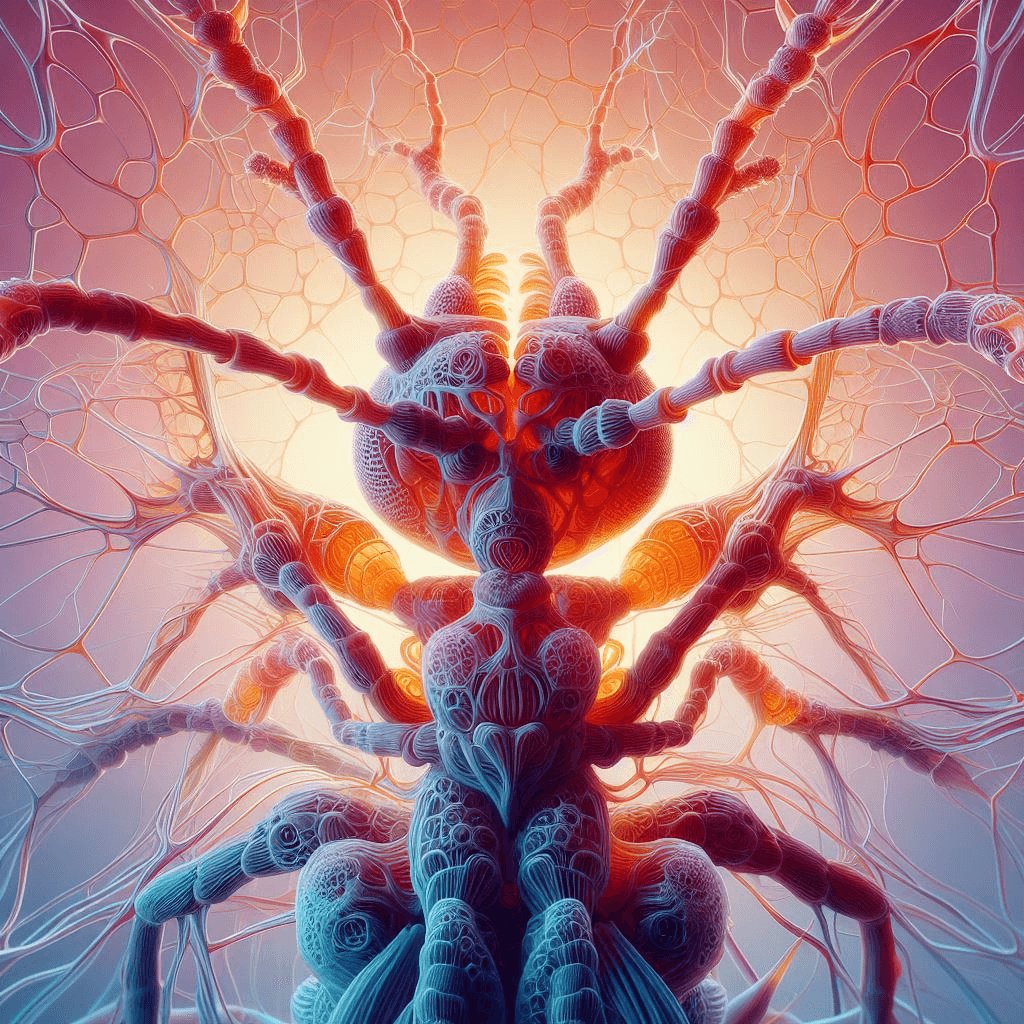From their industrious nature to their elaborate social structures, ants have captivated human curiosity for centuries. These tiny creatures belong to the order Hymenoptera and are part of the vast world of terrestrial metazoa. With over 12,000 known ant species, each with its own unique behaviors and adaptations, these minuscule insects are a constant source of wonderment.
Now, let’s delve more forcibly into a captivating question that has puzzled many curious minds — do ants possess lungs? Breathing is essential for most living organisms, including humans.
We inhale oxygen and exhale carbon dioxide to sustain our metabolic processes. But what about ants and other creatures?
Are ants strong because they are equipped with similar respiratory systems? Join us on this intellectual journey as we explore the intricacies of ant anatomy and unravel the mysteries of their remarkable respiration.
Ants have long been regarded as impressive creatures due to their remarkable ability to work together in harmony and achieve extraordinary feats. From constructing intricate nests to foraging tirelessly for food, these industrious insects never fail to astound us with their strength and organization.
Additionally, ants’ permanent social parasites or facultative slave-makers add an extra layer of complexity to their already fascinating existence. So now we pose a thought-provoking question – do ants have lungs?
As humans, our respiratory system relies on efficient lung function for breathing. However, it’s important not to assume that other organisms share our biological traits.
In this article, we’ll embark on an enthralling exploration into the respiratory system of ants and uncover whether these incredible creatures possess lungs like ours or if they utilize alternative methods to facilitate respiration. Stay tuned as we embark on an enthralling journey through the microscopic world of ants’ respiratory systems, unraveling their secrets one tiny tube at a time.
Ant Anatomy: Understanding the Basics

Ants, those tiny creatures that scurry around tirelessly, have remarkably complex body structures. Like all insects, ants have three main body segments: the head, thorax, and abdomen.
The head houses their sensory organs, including two compound eyes and a pair of antennae that help them navigate their environment with precision. The thorax is where the six legs are attached, enabling ants to scuttle swiftly in search of food or during slave raiding expeditions.
The abdomen contains vital organs like the digestive system and reproductive organs. This segmented body structure allows ants to move flexibly and efficiently.
Highlighting key organs and their functions
Within their segmented bodies, ants possess a range of essential organs that contribute to their survival. One such organ is their heart, which pumps colorless blood (hemolymph) throughout their bodies instead of red blood cells like in humans.
This hemolymph transports nutrients to various tissues within an ant’s body while also aiding in waste removal. Additionally, ants possess a unique respiratory system composed of tiny tubes called tracheae.
These tracheae start from openings on the sides of their abdomens called spiracles. It is through the body called spiracles, that ants inhale oxygen-rich air for respiration.
Understanding these fundamental aspects of ant anatomy sets the stage for exploring how they breathe without lungs. It’s fascinating how such small creatures have developed their own version of efficient respiration, allowing them to survive floods or even an ice age!
Breathing in Ants: The Respiratory System
Ants, like many other insects, have a unique way of breathing that sets them apart from vertebrates. Unlike us humans who rely on lungs to extract oxygen from the air, ants have developed a remarkable respiratory system that allows them to effectively breathe without lungs. Instead of using specialized organs like lungs, ants use a network of tiny tubes called tracheae.
These tracheae run throughout the ant’s body and deliver oxygen directly to their cells. This ingenious adaptation enables ants to thrive in diverse environments and carry out their complex activities.
Introducing the tracheal system as a unique respiratory adaptation
The tracheal system is an intricate network of tubes that permeates almost every cell and part of an ant’s body. Similar to how our blood vessels distribute oxygen throughout our bodies, the tracheae serve as channels for delivering air directly to the insect’s tissues.
At various points along these tubes are small openings called spiracles, which are essentially holes in the ant’s exoskeleton. These spiracles act as entrances and exits for air, allowing oxygen to enter and carbon dioxide (a byproduct of respiration) to be expelled.
This highly efficient respiratory mechanism enables ants not only to survive but also thrive in different habitats, whether it be underground tunnels or towering tree canopies. The spiracles can open or close depending on the needs of the ant, ensuring optimal gas exchange while protecting against water loss in arid environments or potential contamination by foreign particles.
Entomologist Ted Schultz has extensively studied this fascinating aspect of ant biology and found that certain species exhibit modified tracheal systems suited for their specific ecological roles. For instance, slave-raiding ants may have enlarged spiracles that allow for more rapid gas exchange during intense predatory activities.
Additionally, ants that protect aphids, which produce honeydew, may have specialized tracheae that facilitate the collection and distribution of this sugary substance within their colonies. Ants have evolved a truly remarkable respiratory system that allows them to thrive in their diverse habitats.
Through the use of tracheae and spiracles, these tiny terrestrial metazoa can efficiently extract oxygen from the air and release carbon dioxide. This unique adaptation is a testament to the incredible versatility and resilience of these industrious insects.
Tracheal System: The Ants’ Air Tubes

Ants, like many other insects, lack lungs. Instead, they possess a highly efficient respiratory system called the tracheal system. It consists of a network of tiny tubes known as tracheae that run throughout their bodies.
These tracheae are made up of a tough yet flexible material called chitin, which allows them to maintain their shape even when the ants move or flex. The structure and distribution of these tracheae vary based on the ant species and their specific needs.
In general, however, the larger ants tend to have more complex and extensive networks of tracheae compared to smaller species. This intricate system ensures that oxygen can reach every part of an ant’s body efficiently.
Discussing how spiracles serve as breathing openings for ants
To facilitate respiration, ants possess openings on their exoskeleton called spiracles. These spiracles act as the primary entrance points for air into the tracheal system.
Their number and location vary across different parts of an ant’s body but are most commonly found along its abdomen or thorax. When an ant breathes, it opens its spiracles to allow air to flow in through these tiny holes.
Interestingly, some species may exhibit adaptations in their spiracles depending on their particular requirements or environment. For instance, certain ants that dig deep underground tunnels may have enlarged spiracles near their head or legs to enhance oxygen intake during intensive digging activities.
The fascinating aspect about these breathing openings is that ants have control over them; they can open or close them at will! This ability allows them to regulate gas exchange efficiently while preventing water loss through excessive evaporation when conditions are dry or unfavorable.
While ants do not possess lungs like humans and other terrestrial metazoa, their tracheal system, comprised of intricate networks of tiny tubes called tracheae and specialized breathing openings called spiracles, allows them to efficiently exchange gases and obtain the oxygen they need for respiration. This unique adaptation in ants showcases their remarkable ability to thrive in diverse environments and reinforces the wonder and complexity of nature’s creations.
Gas Exchange in Ants: How Oxygen Gets In, Carbon Dioxide Gets Out
When it comes to breathing, ants have a clever system that doesn’t involve lungs like we humans have. Instead, they rely on tiny tubes called tracheae and small openings on their bodies called spiracles. Oxygen enters an ant’s body through these spiracles and travels through a network of fine tracheal tubes that branch out to reach every part of their body.
This intricate system ensures that sufficient oxygen is delivered directly to the ant’s tissues for respiration. The tracheae play a leading role in this process, acting as transport highways for oxygen to efficiently reach all the cells and organs within an ant’s body.
Explaining how carbon dioxide is expelled from ants’ bodies
Just as ants breathe in oxygen, they also need a similar way to release carbon dioxide—the waste product of respiration—out of their bodies. Once inside the ant, oxygen diffuses across the membranes into cells where it is utilized for energy production. As a result of this metabolic activity, carbon dioxide is generated as a byproduct.
To eliminate this waste gas, carbon dioxide diffuses back out through the same network of tracheae and spiracles. The exhaling process in ants occurs passively due to differences in concentration gradients between the body tissues and external environment.
By relying on this simple yet effective gas exchange mechanism, ants maintain their respiratory needs without requiring lungs like us vertebrates. By adopting such unique methods for respiration without relying on lungs or gills found in most insects or other terrestrial metazoa, ants demonstrate their remarkable adaptability as successful social insects.
Adaptations for Efficient Respiration in Ants
Ants, like other insects, do not possess lungs. Instead, they have their own version of a respiratory system that relies on a remarkable array of adaptations.
One such adaptation is the presence of enlarged spiracles and modified tracheae in their bodies. Spiracles are tiny openings located on the ant’s exoskeleton, through which air enters and exits the tracheal system.
In certain ant species, these spiracles can be visibly larger than in other insects. The enlarged spiracles allow for a more efficient exchange of gases between the atmosphere and the tracheae within the ant’s body.
Variations among Ant Species
The respiratory adaptations among different ant species vary significantly based on their unique ecological niches and behaviors. For example, ants that engage in slave raiding or those that are permanent social parasites often exhibit modified respiratory structures to support their aggressive or parasitic lifestyles.
Some species may have specialized adaptations to withstand oxygen scarcity in underground tunnels or high carbon dioxide levels within densely packed colonies. Consider an intriguing study by entomologist Ted Schultz who observed certain ants using their antennae to detect alarm signals related to changes in oxygen levels within their nests.
This sensory ability allows them to respond quickly by adjusting their ventilation rates or seeking alternative routes to ventilated areas. While ants may not possess lungs like humans do, they have evolved a highly efficient respiratory system with specialized features such as enlarged spiracles and modified tracheae.
These adaptations not only aid gas exchange but also provide variations among different ant species based on their unique needs and environments. Exploring these incredible aspects of how ants breathe further deepens our appreciation for these fascinating creatures’ remarkable adaptability and captivating world beneath our feet.
Fun Facts about Ant Respiration
One fascinating aspect of ant respiration lies in their ability to close their spiracles when submerged in water. Imagine tiny ants taking an unexpected plunge into a puddle or encountering a flooded tunnel. In such situations, ants display their remarkable adaptation by sealing off their spiracles, preventing water from entering their respiratory system.
This ingenious mechanism allows them to survive underwater for extended periods, as they conserve the air trapped inside their bodies. It is like wearing a waterproof diving suit, but for ants!
Studies Uncover Intriguing Observations
Scientists have conducted captivating studies to gain insights into ant respiration and its unique characteristics. One particular study observed the fascinating behavior of enslaved ants within colonies of permanent social parasites, such as slave-making ants or brood parasites. These parasites rely on “enslaved” worker and queen ants from other species to support and care for their own colonies.
Remarkably, researchers discovered that these enslaved ants often possess modified tracheal systems compared to free-living ants. This adaptation enables them to provide sufficient oxygen not only for themselves but also for the whole labor force working tirelessly in the parasite’s colony.
Ants: Masters of Their Own Respiratory System
While most insects breathe primarily through spiracles and tracheae, each species has its own version of respiratory adaptations based on its unique lifestyle and needs. Some ant species have enlarged spiracles that facilitate efficient gas exchange during strenuous activities or high metabolism for long periods alone. Additionally, observations have shown that an ant’s movement plays a significant role in aiding respiration.
For instance, when an ant engages in rapid movements like running or climbing, it helps increase airflow through its tiny tubes—essentially adding some cardio exercise to its already busy life. Ant respiration offers a fascinating glimpse into the intricacies of these remarkable creatures.
Their ability to seal off spiracles underwater, observations related to enslaved ants in social parasite colonies, and the way their respiratory system adapts to different lifestyles all contribute to our growing understanding of the complex world of ant respiration. These fun facts serve as a reminder that even the tiniest organisms have their unique survival strategies and secrets waiting to be discovered.
Conclusion
In this article, we have explored the fascinating world of how ants breathe, and their remarkable respiratory system. Unlike humans and many other animals, ants do not possess lungs to facilitate breathing. Instead, they rely on a unique network of air tubes called tracheae and small openings in their bodies called spiracles.
Through these tiny holes, oxygen is diffused into ant tissues while carbon dioxide is expelled. This efficient system allows ants to meet their oxygen needs without the need for lungs.
Highlighting the remarkable adaptability and efficiency of these tiny creatures
Ants are truly extraordinary creatures when it comes to adaptation and efficiency. Their ability to breathe without lungs showcases their incredible resilience in finding innovative solutions for survival.
The tracheal system in ants not only enables them to efficiently breathe underwater exchange gases but also allows them to thrive in various environments, including underground nests or even submerged in water for short periods. Their adaptability extends beyond respiration; ants have survived throughout different geological periods, including the ice age, proving their tenacity as terrestrial metazoa.
This unique respiratory adaptation also demonstrates the intricacies of nature’s design. Ants have evolved specialized features like enlarged spiracles or modified tracheae to optimize respiration according to their specific needs within diverse ecosystems.
Entomologist Ted Schultz discovered that some slave-making ants even possess a subgenual organ that detects vibrations from alarm signals produced by captured slave workers. While ants may be small in size, their respiratory system is a testament to the wonders of nature’s engineering genius.
Their ability to breathe without lungs is an awe-inspiring adaptation that highlights both their adaptability and efficiency as highly social insects. So next time you observe an ant scurrying by, take a moment to marvel at its seemingly mundane yet incredibly complex way of breathing, and remember that even the tiniest creatures can hold captivating secrets waiting to be discovered.
Prevent Ant Problems with D-Termination: Las Vegas’ Top Pest Control Solution!

If you’re dealing with ant infestations, turn to D-Termination for assistance. Our skilled team specializes in deterring ants, rejuvenating cleanliness, and maintaining the integrity of your environment. Bid farewell to ants—opt for D-Termination for highly effective pest control today!
Reach out to us at 702-919-6310 or visit dtermination.com to schedule your ant control service and regain control of your space from these unwanted pests.
Frequently Asked Questions:
Ants breathe through tiny tubes called tracheae.
Ants have a simple circulatory system but no centralized heart.
Ants can survive for varying durations without air, depending on the species and environmental conditions.
Ants likely do not feel pain in the way humans do; they respond to stimuli but lack the capacity for emotional pain.








